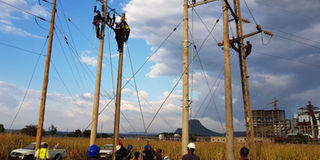Uganda’s electricity export earnings decline to Shs96b

Uganda exports much of its power to parts of western Kenya, Tanzania, eastern DR Congo and South Sudan. Photo | File
What you need to know:
- Ms Pamela Nalwanga Byoruganda, the UETCL public relations officer, yesterday said Kenya had increased generation capacity, especially in the western part of the country in which much of Uganda’s exported electricity is consumed.
Uganda earned $25.64m (Shs96b) from electricity exports in the year ended August, according to details from Bank of Uganda.
However, the earnings fell by 95 per cent compared to what the country earned in the same period ended August 2019.
Data from Bank of Uganda indicates that during the period between August 2019 and August 2020, earnings from electricity exports declined to $25.64m (Shs96b) compared to $50m (Shs187b) earned in the same period ended August 2019.
The decline, Uganda Electricity Transmission Company Limited (UETCL), said yesterday was occasioned by reduced demand from Kenya.
Uganda exports much of its electricity to Kenya but also exports to parts of Tanzania, eastern DR Congo and South Sudan.
According to Bank of Uganda, about 261,077 megawatts were exported during the period, which was a decline from the 311,428 megawatts in the same period to August 2019.
Ms Pamela Nalwanga Byoruganda, the UETCL public relations officer, yesterday said Kenya had increased generation capacity, especially in the western part of the country in which much of Uganda’s exported electricity is consumed.
“Most of our exports go to western Kenya. What has happened is that Kenya has increased its generation capacity and worked on its lines to the region. So, they do source electricity as per demand,” she said without giving more details.
Uganda currently has installed capacity of 1,242.15 megawatts, out of which, on average, only 728 megawatts is consumed for both domestic and export purposes.
On average, at least 650 megawatts are consumed locally. But this had reduced to about 500 megawatts during Covid 19-related lockdown.
However, Ms Byoruganda noted consumption has been rebuilding since June when the lockdown was lifted.
Currently, she said, local consumption stands at about 642 megawatts.
Earlier, UETCL had indicated that Uganda’s generation capacity is expected to grow to 1,681 megawatts by the end of this year.
Last year, Kenya indicated it had increased its power imports from Uganda due to a reduction in tariffs from Shs787.3 to Shs501 per unit.
Kenya’s Energy Cabinet Secretary Charles Keter, said at the time the sharp growth in electricity imports from Uganda had been informed by tariff reductions of about 50 per cent.
The increase, Mr Keter said then had been informed by an increase in the price of power generated by Muhoroni, which largely supplies western Kenya.
The price of power had then increased to Shs1,252.6, was twice the price of the Shs501 per unit.
Price decline
Kenya had last year indicated that its power import price from Uganda was expected to reduce to Shs357.8 at the end of October, which Mr Keter said would give the country a stability amid rising demand.
Kenya has an installed capacity of 2.3 gigwatts of which 52.1 per cent is hydro while 32.5 per cent is generated from fossil fuels. At least 13.2 per cent is generated from geothermal, 1.8 per cent from biogas cogeneration and 0.4 percent from wind, respectively.
The country has an electricity demand of 1,600 MW, which is projected to grow to about 2,600-by the end of this year. As of 2018, 6.9 million Kenyans had been connected to the grid, which is three quarters of the total population.




